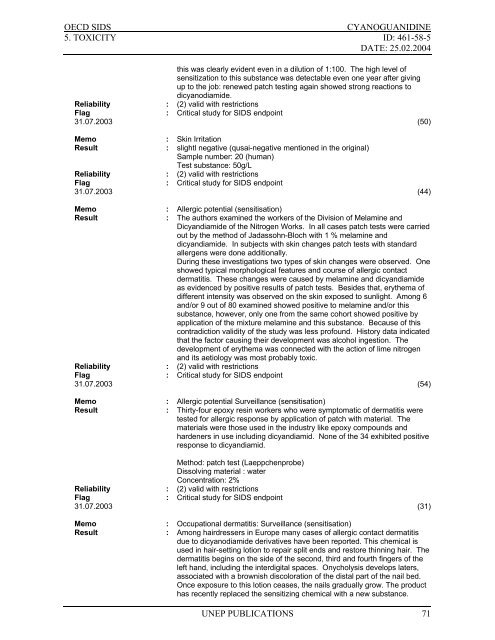Cyanoguanidine CAS N°: 461-58-5
Cyanoguanidine CAS N°: 461-58-5
Cyanoguanidine CAS N°: 461-58-5
You also want an ePaper? Increase the reach of your titles
YUMPU automatically turns print PDFs into web optimized ePapers that Google loves.
OECD SIDS<br />
CYANOGUANIDINE<br />
5. TOXICITY ID: <strong>461</strong>-<strong>58</strong>-5<br />
DATE: 25.02.2004<br />
this was clearly evident even in a dilution of 1:100. The high level of<br />
sensitization to this substance was detectable even one year after giving<br />
up to the job: renewed patch testing again showed strong reactions to<br />
dicyanodiamide.<br />
Reliability : (2) valid with restrictions<br />
Flag : Critical study for SIDS endpoint<br />
31.07.2003 (50)<br />
Memo : Skin Irritation<br />
Result : slightl negative (qusai-negative mentioned in the original)<br />
Sample number: 20 (human)<br />
Test substance: 50g/L<br />
Reliability : (2) valid with restrictions<br />
Flag : Critical study for SIDS endpoint<br />
31.07.2003 (44)<br />
Memo : Allergic potential (sensitisation)<br />
Result : The authors examined the workers of the Division of Melamine and<br />
Dicyandiamide of the Nitrogen Works. In all cases patch tests were carried<br />
out by the method of Jadassohn-Bloch with 1 % melamine and<br />
dicyandiamide. In subjects with skin changes patch tests with standard<br />
allergens were done additionally.<br />
During these investigations two types of skin changes were observed. One<br />
showed typical morphological features and course of allergic contact<br />
dermatitis. These changes were caused by melamine and dicyandiamide<br />
as evidenced by positive results of patch tests. Besides that, erythema of<br />
different intensity was observed on the skin exposed to sunlight. Among 6<br />
and/or 9 out of 80 examined showed positive to melamine and/or this<br />
substance, however, only one from the same cohort showed positive by<br />
application of the mixture melamine and this substance. Because of this<br />
contradiction validity of the study was less profound. History data indicated<br />
that the factor causing their development was alcohol ingestion. The<br />
development of erythema was connected with the action of lime nitrogen<br />
and its aetiology was most probably toxic.<br />
Reliability : (2) valid with restrictions<br />
Flag : Critical study for SIDS endpoint<br />
31.07.2003 (54)<br />
Memo : Allergic potential Surveillance (sensitisation)<br />
Result : Thirty-four epoxy resin workers who were symptomatic of dermatitis were<br />
tested for allergic response by application of patch with material. The<br />
materials were those used in the industry like epoxy compounds and<br />
hardeners in use including dicyandiamid. None of the 34 exhibited positive<br />
response to dicyandiamid.<br />
Method: patch test (Laeppchenprobe)<br />
Dissolving material : water<br />
Concentration: 2%<br />
Reliability : (2) valid with restrictions<br />
Flag : Critical study for SIDS endpoint<br />
31.07.2003 (31)<br />
Memo : Occupational dermatitis: Surveillance (sensitisation)<br />
Result : Among hairdressers in Europe many cases of allergic contact dermatitis<br />
due to dicyanodiamide derivatives have been reported. This chemical is<br />
used in hair-setting lotion to repair split ends and restore thinning hair. The<br />
dermatitis begins on the side of the second, third and fourth fingers of the<br />
left hand, including the interdigital spaces. Onycholysis develops laters,<br />
associated with a brownish discoloration of the distal part of the nail bed.<br />
Once exposure to this lotion ceases, the nails gradually grow. The product<br />
has recently replaced the sensitizing chemical with a new substance.<br />
UNEP PUBLICATIONS 71
















